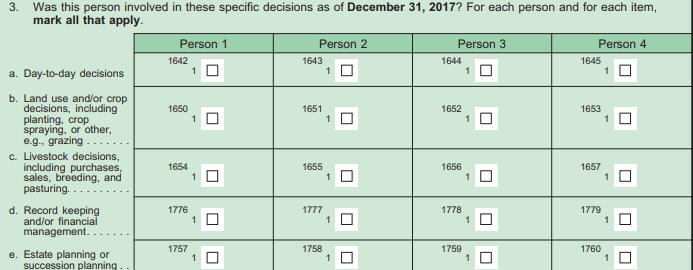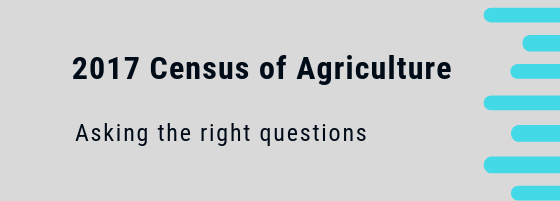By Doris Mold
On April 11, 2019, the first results from the 2017 Census of Agriculture will be released. I am excited about what the new Census is going to tell us.
Why would someone get excited about a bunch of statistics?
Because this year there is a very good chance that we are going to see a dramatic shift in the number of women farmers—perhaps as much as a 25% increase. This change is exciting because it indicates we are beginning to learn the true story of women in agriculture and farming. With the excitement, however, comes some trepidation as the media may take the “wow” factor and run with it, asking questions like “Why are we seeing an increase?” “Are women suddenly being attracted to farming as a profession?” “Have they broken through the age-old glass ceiling of farming?”
The answer is, “Not exactly.” Some of the increase will no doubt come from new women entering farming. This is what I am afraid the media will focus on, making it look like women are suddenly entering farming in droves.
The larger and less exciting truth, though, is that we are starting to ask the right questions on the Ag Census. Women, who have been farming in the past but have not been counted, are starting to be included.
With these revised questions we’ll also hopefully have a clearer picture of a younger generation of farmers farming with the older generations.
These changes came about because after the 2012 Census of Agriculture, the National Agricultural Statistic Service (NASS) received feedback from stakeholders, including myself, who believed that the roles of women and of new or beginning farmers were not fully captured by the questions in the Census questionnaire. In response to these concerns, NASS commissioned a panel of experts in 2015 to look at “Federal Statistics on Women and Beginning Farmers in U.S. Agriculture.” The panelists, experts in economics, sociology, statistics, policy, and agriculture, were drawn from the academic, government, and agricultural sectors. I was fortunate to be one of the people called to serve on this panel.
The Census of Agriculture is conducted every five years. Up until 2002, the Census accounted for only one operator per farm operation. Then, from 2002 until the 2012 Census, only one person could be identified as the principal operator—the person in charge. There was no way to show shared decision-making—everyone else was considered a subordinate. In most cases, even if there were multiple family members operating the farm and making decisions, families would stick with tradition and name the most senior male as the principal operator of the farm.
As many farms have grown over the years, however, more people are involved in managing different aspects of the farming operations. Even with smaller farms, numerous studies have shown that husbands and wives or parents and children farming together often share the management and decision-making duties of the farm.
During the panel process, we had lengthy deliberations on how to do a better job of counting women and the multiple generations that could be involved in a single farm. We understood that getting better statistics would take time, especially considering that there are cultural reasons for some of the responses or lack of response.
The end result of the panel’s work was a change in the 2017 Census, with new questions and a bit of a different approach.
The next several two show some of the most important changes from the 2012 Census to the 2017 Census.


Figure 1: Questions changed from asking about “operators” on the 2012 Census of Agriculture to asking about persons on the 2017 edition.

Figure 2: Questions about who makes the decisions were added to the 2017 Census of Agriculture.
The biggest changes are that the questions no longer ask for a single principal operator, and they consider a full range of farm management decisions.
To make such sweeping changes requires rigorous testing. Over 17,000 farms participated during the 2015 testing phase preparing for the 2017 Ag Census. NASS winnowed that sample down to those who answered a minimum of four questions in the Personal Characteristics section, and then further narrowed down responses to those who had completed both the 2012 Census and the 2015 test. Finally, farms had to report the total number of operators in both 2012 and 2015 to be included in the final calculation, leaving 7,106 responses that could be used to calculate whether there was a change based on the new questions.
The results of the testing showed the total number of women reported increasing from 3,352 “operators” in 2012 to 4,179 “decision makers” in 2015, which is a 25% increase. While it’s an impressive shift upward, we’ll see if this increase holds in the 2017 Ag Census final results.
Also, while these numbers are coming closer to telling the true story of the involvement of women in farming, we are still likely to see lower numbers than reality due to cultural norms. The final report on the testing revealed that “cultural biases constitute the biggest obstacle to complete and accurate reporting.” The findings continued:
Cognitive testing reveals strong predilection for relegating the roles of women in agriculture to inferior status or not seeing women as decision-makers, even acting jointly. Statements made by participants during testing included, ‘We always argue her down’; ‘She just does the bookkeeping’; ‘The Bible says he’s in charge and that is what I am putting down.’
The order in which questions were asked is also important: some people did not realize that record keeping/financial management would be included. As a result, respondents left women off on the front end and would not go back to add them after completing the other questions.
Additionally, although the panel recommended that marketing be included in the questions concerning decision-making, it was left out. Many women play a role in farm marketing, and by leaving this question out, it eliminates the potential of capturing some additional women. The omission has been pointed out, and we have been assured that it will be included in the 2022 Census.
Making judgments without the correct data, with entrenched cultural attitudes and without including women impacts policy decisions, roles in agricultural organizations, lending, legal, and other business considerations. The 2017 Census results should yield better data and better information, and that should in turn yield better understanding and decision-making.
Doris Mold is the president of Sunrise Agricultural Associates LLC, an agricultural consulting firm, and is a farm co-owner/operator. Since 2015, she has served on expert national panels for the USDA Census of Agriculture and the National Academy of Science. Mold served six years on the Agricultural Statistics Advisory Committee for the National Agricultural Statistics Service and chaired the committee for three years.



